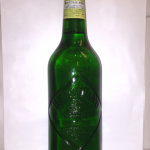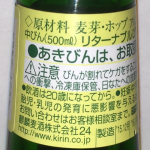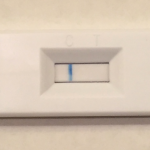During my recent trip to Japan I had the chance to try locally brewed beers. I bought a bottle of Kirin Heartland actually because of the nice bottle. Taste was average, malty with a good finish.
Beer: Kirin Heartland
Producer: Kirin Brewery / 麒麟麦酒株式会社
Originating country: Japan
Brewing location: Japan
Bottle size: 0.5 l = approx. 16 Oz.
Alcohol by volume: 5.0%
Ingredients: water, barley malt, hops
Miscellaneous: ABV and ingredients according to internet research as I wasn’t able to read the label
Test Kit: GlutenTox Home Kit
I tested with a threshold of 5 ppm. The limit of detection depends on the number of drops taken from the extraction solution, please find some more information here.
Test result: There is no indication of the presence of gluten above 5 ppm. According to the instructions there should appear a clearly visible red test line on the right of the test area ( T ) to indicate the presence of gluten. The blue line on the left test area ( C ) is a control line and indicates that the extract/sample is suitable, the test has been performed correctly and all reagents are active. Please don’t take any of my test results as a medical advice – see my facts page.




big in japan
Thanks for doing this one. I’m an American living in Japan, and Kirin Heartland is my favorite major (more or less) Japanese beer. I was diagnosed with Hashimoto’s a few weeks ago, and am giving GF a try. It’s nice to know that one Heartland might be tolerable now and then.
I never really gave gluten a second thought, but it explains something that happened a few months ago: I found some Paulaner Weissbier locally, and I hadn’t had it in years so I bought a few bottles. But each time I drank it, I felt really bloated, almost inflated, like never before.
In the meantime, I’m drinking Nodogoshi, which is a “third-class beer” (very little or no malt) that’s made with soy protein rather than barley or wheat. It doesn’t taste very good, but it’s my only option for a session.
I’m wondering how 5ppm in a 500ml beer compares to other gluten ingestion. For example, if I make my daughter a ham sandwich, touch the bread, then eat a piece of ham with my fingers, have I ingested more gluten than would be in one of the “safer” beers on your list? I wonder.
Anyway, keep up the good work! I was very glad to find your site.
Steffen
Hi big in japan,
First of all, I am jealous. You live in such a beautiful country. I been there only once and I loved it. Sorry to hear you are suffering from Hashimoto. It’s so strongly increasing with all the autoimmune diseases.
Well, you do right – it’s tolerable from time to time if you suffer from gluten severely. For me and others it seems to be no problem but the sensitivity varies. I can handle quite a lot of gluten without notable effects.
Re the contaminations (even though I don’t like this word – it reminds me more to Fukushima than to gluten) I also wonder how much gluten it could be when I e.g. use the same bread knife for gluten containing and gluten free bread. I would assume in beer is less gluten then. 5 ppm is 5 parts per million and bread crumbs maybe has much more. But again I can handle bread crumbs without problem.
Cheers Steffen
big in japan
Well, if truth be told, I’d much rather be in Germany… both for the scenery and the beer! I lived in B-W twice as an exchange student, many years ago.
Here’s another thing I’ve been wondering about: how would the so-called gluten-free beers (like Brunehaut, for example) perform on your tests? If 20ppm is the generally accepted cut-off level, I wonder if some of the GF-labeled beers might actually have more gluten than some of the standard beers you’ve tested.
Steffen
Hi BiJ,
I liked it in Japan but Germany is also OK.
I tested two beers which are labelled gluten free. Estrella Damm, result here:
http://www.lowgluten.org/estrella-daura-damm-gluten-test/
and Ambar Expecial:
http://www.lowgluten.org/ambar-especial-gluten-test/
The next one I want to test is Kukko which claims to be the first gluten free beer in the world:
http://deski.fi/9/the-first-gluten-free-beer-in-the-world-comes-from-laitila-1173
Anyone has contact details of Kukko to get a free sample beer and test it?
Cheers Steffen